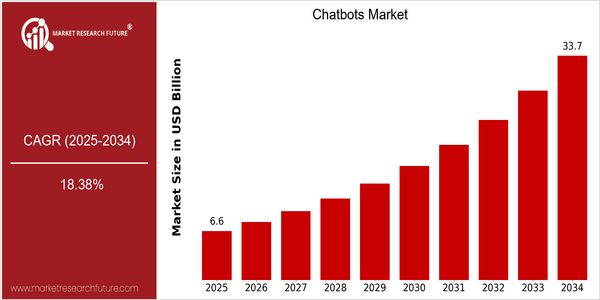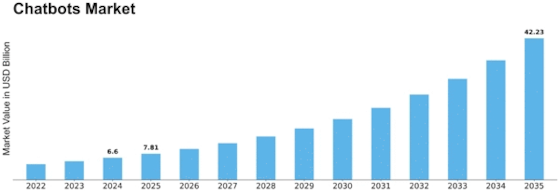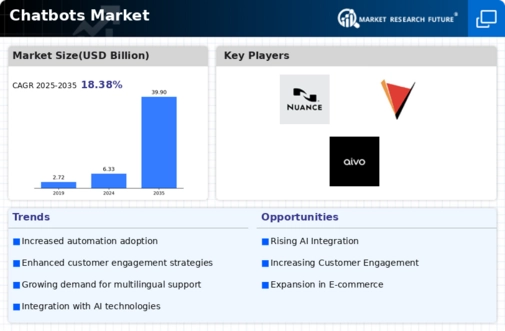Chatbots Size
Market Size Snapshot
| Year | Value |
|---|---|
| 2025 | USD 6.6 Billion |
| 2034 | USD 33.7 Billion |
| CAGR (2025-2034) | 18.38 % |
Note – Market size depicts the revenue generated over the financial year
The world chatbot market is expected to grow rapidly from $ 6.6 billion in 2025 to $33 billion in 2034. This remarkable growth rate will be 18.38% in the forecast period. The main reason is the increasing use of artificial intelligence and natural language processing (NLP) technology, which enables companies to enhance customer service and optimize internal operations through automation. The demand for continuous customer service and the trend of digital transformation in all industries have driven the integration of chatbots into customer service systems. The leading companies in the chatbot market, such as Microsoft, Google, and IBM, have made significant investment in the development of new products and formed strategic alliances to enhance their offerings. Their platforms, such as the Microsoft Azure Bot Service and the Google Dialogflow, are able to create more advanced chatbots. Also, companies are increasingly developing industry-related chatbots to meet the unique needs of different industries, thereby driving the market growth. The research shows that the market will be more mature and the adoption rate will be higher.

Regional Market Size
Regional Deep Dive
CHATBOT MARKET is experiencing significant growth across various regions, driven by the advancements in artificial intelligence, natural language processing, and the growing demand for customer support automation solutions. The market is characterized by the high adoption rate of chatbots in the North American region, as they help enhance customer engagement and optimize operations. In Europe, the market is characterized by a diverse regulatory environment, affecting chatbot deployment. Asia-Pacific is rapidly becoming the innovation hub for chatbots, especially in the banking and e-commerce industries. Middle East and Africa are slowly adopting chatbots, aided by government initiatives for digital transformation. Latin America is also adopting chatbots, especially in customer support and marketing, to enhance efficiency and customer satisfaction.
Europe
- The European Union's General Data Protection Regulation (GDPR) has prompted companies to develop chatbots that prioritize user privacy and data protection, influencing design and functionality.
- Innovative startups such as Ada and Chatfuel are gaining traction, offering tailored chatbot solutions that cater to specific industries, including healthcare and finance.
Asia Pacific
- Countries like China and India are leading the charge in chatbot adoption, with significant investments from companies like Alibaba and Haptik focusing on enhancing user experience in e-commerce.
- The region is witnessing a surge in AI research and development, with government initiatives in countries like Singapore promoting the use of chatbots in public services and citizen engagement.
Latin America
- Brazil is seeing a rise in chatbot usage among small and medium enterprises, driven by the need for cost-effective customer service solutions.
- Companies like Take Blip are leading the way in developing localized chatbot platforms that cater to the diverse linguistic and cultural landscape of Latin America.
North America
- Major tech companies like Google and Microsoft are investing heavily in AI-driven chatbot solutions, enhancing their capabilities and integration with existing platforms.
- The rise of remote work has accelerated the adoption of chatbots in customer service, with organizations like Zendesk reporting increased demand for automated support solutions.
Middle East And Africa
- The UAE government has launched initiatives like the 'Smart Dubai' project, which aims to integrate AI and chatbots into public services to improve efficiency and citizen interaction.
- Local startups such as Botme and Aitomation are emerging, focusing on providing chatbot solutions tailored to the unique cultural and business needs of the region.
Did You Know?
“Approximately 80% of businesses are expected to use chatbots by 2025, highlighting the growing reliance on automated solutions for customer interaction.” — Gartner
Segmental Market Size
The Chatbots Market is undergoing a fast growth, mainly driven by the growing demand for efficient customer service solutions. The other key factors driving this market are the increasing need for round-the-clock customer support and the technological developments in the field of natural language processing (NLP). Chatbots are increasingly used to improve customer engagement and to optimize operations, especially in e-commerce and banking. Chatbots are currently in the implementation phase, with companies such as Drift and Intercom setting the standards for customer engagement automation. The most common applications of chatbots are in retail, where companies like Sephora use them to offer personal shopping advice, and in the health care sector, where companies like Babylon Health use them for patient triage. The macro-economic trends such as the flu pandemic COVID-09 have accelerated the digitalization of the economy and prompted companies to adopt chatbots for remote customer service. Artificial intelligence and machine learning are shaping the evolution of chatbots and enabling more sophisticated and context-aware interactions that meet the growing customer expectations.
Future Outlook
In the period from 2025 to 2034, the market is expected to grow from $ 6.6 billion to $33.7 billion, with a CAGR of 18.38%. Artificial intelligence and natural language processing have become the two most important enabling technologies for the development of chatbots. In the field of customer service, e-commerce and medicine, these two technological breakthroughs have already greatly improved the quality of chatbots. It is expected that more than 70% of enterprises will use some form of chatbots by 2034, driven by the need to improve customer service and optimize internal processes. The introduction of machine learning and voice recognition will also drive the market. The importance of omni-channel strategies and the need for individualized services will also open up opportunities for the development of chatbots. The rise of conversational commerce and the increasing use of chatbots in the field of mental health will also change the market. In the future, the market will continue to grow and become an important part of digital transformation strategies.


















Leave a Comment